Assessment of Fire Risk in Passenger Trains in Tunnels Using the FMEA Model and Fuzzy Theory (A Case Study in the Zagros Railway)
Hossein Shahbaz Nezhad1 * , Hassan Zivdar2 and Azizollah Amirnia1
1
University Municipality of Andimeshk,
Andimeshk,
Iran
2
Science and Industry University,
Garz,
Germany
Corresponding author Email: hosseinshahbaznezhad@yahoo.com
DOI: http://dx.doi.org/10.12944/CWE.10.Special-Issue1.137
A part of Zagros railway is located in Zagros Mountains which has various long tunnels since this railway passes through a mountainous, hard-to-pass area. Some characteristics of these tunnels include inadequate cross section and free space relative to the wagon size, arcs with small radius, location on the slope, lack of proper ventilation, and the lack of road access to the rescue. So, the necessity of research into possible fire in railway passenger trains in tunnels becomes clearer. The results showed that in the assessment of fire risks in passenger trains inside tunnels through FMEA model, two types of fire risks are encountered. The first type risk (prior to fire) included risks that can lead to fire in passenger trains, and the most important (first priority) of them are the high temperature of turbochargers of the generators, fire in the manifold of engine exhaust, and the spilling of fuel from the injector pump pipe assembly, and output connector hoses leading from the engine assembly. Also, the events that can happen after a fire in trains are not less important than the factors leading to fire. The most important and high risks especially in tunnels 22 and 23 of Zagros ( the longest tunnels in this area) are the immediate location of cliffs at the exit mouths of these tunnels to the exit of the tunnel, difficulty of the evacuation of passengers in case of fire, and the passengers’ rush to the exit doors.
Copy the following to cite this article:
Nezhad H. S, Zivdar H, Amirnia A. Assessment of Fire Risk in Passenger Trains in Tunnels Using the FMEA Model and Fuzzy Theory (A Case Study in the Zagros Railway). Special Issue of Curr World Environ 2015;10(Special Issue May 2015). DOI:http://dx.doi.org/10.12944/CWE.10.Special-Issue1.137
Copy the following to cite this URL:
Nezhad H. S, Zivdar H, Amirnia A. Assessment of Fire Risk in Passenger Trains in Tunnels Using the FMEA Model and Fuzzy Theory (A Case Study in the Zagros Railway). Special Issue of Curr World Environ 2015;10(Special Issue May 2015). Available from: http://www.cwejournal.org?p=794/
Download article (pdf)
Citation Manager
Publish History
Select type of program for download
| Endnote EndNote format (Mac & Win) | |
| Reference Manager Ris format (Win only) | |
| Procite Ris format (Win only) | |
| Medlars Format | |
| RefWorks Format RefWorks format (Mac & Win) | |
| BibTex Format BibTex format (Mac & Win) |
Article Publishing History
| Received: | 2014-11-16 |
|---|---|
| Accepted: | 2014-03-15 |
Introduction
The analysis of failure and its effects dates back to forty years ago. FMEA model was first used in the production of Apollo Spacecraft in NASA in 1960. Then, it was used in nuclear facilities in 1970s and 1980s. In addition, it has been used in the automotive industry since 1977. From 2000 on, it has been regarded as one the most frequently-used methods for assessing risks in all industries.
In order to analyze the potential risks of a phenomenon or crisis, reliable techniques and valid instruments are required. Various methods are used in assessing the fire risk in railway transportation. One example is the assessment of fire risk in subway tunnels using error analysis tree, which was conducted by Daneshvar et al. in Iran in 2013 to identify the causes leading to fire in subway DC trains in Tehran. The evaluation technique of potential defects and its effects (FMEA) is an effective means to know the potential defect states and its effects in order to increase the validity and security in complicated systems, and to collect the required data to make decisions in the risk management. In fact, the aim of using such technique is to identify defects and their effects, to take corrective measures to eliminate or decrease the failure possibility (re-designing the system), and to develop an effective maintenance system to reduce the potential defect states (Bolbol Amiri and Farnad, 2009).
In Iran, Bolbol Amiri and Asadi Lari (2010) studied the assessment of the fire risk in Iranian passenger trains using FMEA and Gray’s fuzzy theory to identify the factors that lead to fire in trains and their causes in the three systems of generators, power and ventilation the passenger wagons and steam generators. In determining the risk factors, first the parameters effective in the fire were discussed in two aspects of performance capabilities in security equipment such as detectors and the material of wagons, and combustion capability. In addition, some organizational failures like lack of adequate care were discussed. For example, the lack of effective control on the flammability of some parts of the wagons is a factor that can intensify the fire effect. In order to evaluate the risk, the theoretical-fuzzy FMEA analysis was used, although the above-mentioned qualitative approach is not as precise as the quantitative, analytic approach, it can help to identify high-risk hazards and to make more precise evaluations. For example, regarding the output of risk evaluation, the defect of the engines is considered as a high risk among the three above-mentioned systems.
Jafarian and Rezvani (2010) presented a study entitled The Evaluation of the Mortality in Adverse Events Caused by Fire in Passenger Trains through the Tree Analyses of Uniform Events. They concluded that 64 different scenarios are possible in the events of fire in passenger trains out of which 24 scenarios were negligible, 24 had marginal consequences, 9 scenarios had serious events, 2 scenarios led to critical consequences, and 2 scenarios led to catastrophic consequences.
In a study entitled Fire Risk Assessment of Overhead Resistance in Tehran Subway Trains with uniform Current through Tree Error Analysis Trees, Daneshvar et al. (2013) sought to identify the causes leading to fire in PC trains in Tehran subways. They suggested that through calculating the possible risks in 1.3 year and frequency distribution of final events of error trees, some factors such as the absence lack of a systematic plan for preventive repairs,, lack of correct services, the inappropriate quality of equipment, the lack of in-built data logger to monitor the temperature changes in roof strength train, and the inappropriate function of the train engineers are the most effective factors that lead to fire in PC trains in Tehran Subway.
In an article entitled The Evaluation of Damages Resulting From Fire In Passenger Trains In Railway Tunnels Through The Hierarchical Analytic Model Of AHP, Zivdar and Shahbaznejad (2014) used some indices such as the radius of the arc, the cross section of the tunnel, the tunnel’s proximity to nearby stations and tunnels window to estimate the vulnerability of tunnels. They also defined five interval-low, average, high, very high, critical. They concluded that over %60of high tunnels of Zagros Railway (depending on the length of the tunnel) lie in the high to critical range of vulnerability against fire.
Hudson (2001) presented a report of fires from 1992 to 1999 in London showing that %44 the railway vehicle equipment and %56 the passenger trains contributed to fire. Almost, 90% of arsons in operational services occurred in East South of London. %53 of arsons were related to operational services. Based on the technical calculations, that % 3of trains and rail vehicles had been burnt.
Seong et al. (2009) embarked on studying the simulation of fire along with the evaluation of life safety. They studied the effects of platform screen doors (PSDs) of two subway stations in the final time that takes the passengers to escape from fire and smoke. The results showed that passengers in subway stations with ventilation system and PSDs had 350 more seconds at their disposal to escape compared to the passengers in platforms without ventilation system and PSDs.Simultaneous with the study of the flow of the smoke resulting from fire, and the concentration of toxic gases and travelers’ sight, the study of different models of ventilation to discharge and control the smoke in tunnels, the subway stations and residential areas was initiated to get comfortable conditions, and reduce the mortalities because of inhalation of toxic gases.
Lin and Chuah (2008) studied the effects of various ventilations in tunnels during fire through simulations. The simulations included single-fan and multiple-fan systems. The critical speed, visibility range, the monoxide and temperature distribution were considered for each case. The results showed that the best performance was for one fan system and the most effective factors for passengers’ escape were visibility and the temperature of smoke layers.
The present study tries to take into consideration the two important issues in the assessment of fire risks prior to and after fire in passenger trains in tunnels which has been ignored in past or has remained as an under-researched topic. For example, in the study conducted by Bolbol Amiri and Asadi Lari (2010), only the risk factors leading to fire in passenger trains were studied using FMEA and theoretical models. Their conclusions are used in the current study. In previous studies, the train fires are considered without taking into account the problematic length of Iranian Railway tunnels. Except for little research into the fire in Tehran subway trains, and in spite of numerous studies conducted abroad, no other research has been conducted in this regard in Iran. It should be noted that the Iranian railway passes through some places such as Zagros, Lorestan and North with hard-to-pass routes and long tunnels. These areas have far more challenges compared to urban railway transportation. The study of these potential risks is the responses to conditions which occur in critical event in long rail tunnels (above 1000 meters) especially in the Zagros Railway. In this area of the Iranian national railway, even the reconstruction and renovation are full of hazards for workers in the tunnels because of lack of ventilation in tunnels, and the existence of toxic gases and much pollution caused by locomotives smokes, which sometimes lead to human mortalities. Perhaps it is supposed that the reciprocating movement of trains inside trains is enough to ventilate the tunnels, but it is effective just in short tunnels, and cannot be enough in long tunnel especially in the small radius curves. Also, the pollution caused by fire mixed with toxic gases from diesels exceed the tolerance threshold.
Research Methodology
The library studies, articles and internet were used to collect the required data on the history, principles and theoretical foundations of applying FMEA in the assessment of fire risks in passenger trains and the crisis of fire in railway tunnels. With the help of the experts’ ideas in evaluating the railway stations and tunnels of Zagros especially in highest one with a cliff directly located after it (tunnel No. 22 in 2481 meters and Tunnel No. 23 in 2525 meters in Tele-zang, Tange 5), and considering the history of firings in longest railway tunnel, the possible fire risks in the Zagros railway tunnels are determined, then the risk priority number (RPN) of each risk is calculated using FMEA model and fuzzy theory.
Procedure
Three points must be emphasized in FMEA: occurrence possibility, severity of risk and detection possibility. The occurrence possibility refers to the possibility or the number of failures in comparison with the number of processes done. The severity possibility refers to the evaluation and measurement the failure result, in fact it is an evaluative scale which defines the seriousness of the failure effects. Also, the detection points to the possibility of failure detection before occurrence. The value and rank of detection depend on the control process. Detection is the control ability to find the causes and mechanisms of failure.
RPN Calculation: the Score of Risk Priority Number
The risk priority number: (severity *occurrence * detection).
Risk can be ranked based on the above three factors. Such classification is from 1 to 10 (bottom to up). If the scores of these factors are multiplied in each other, the risk priority number will be calculated for each pattern of potential risk and its effects. Those failure patterns who have higher RPN should be immediately studied so that its causes can be identified. The obtained RPN is referred to as the risk priority number. It is clear that the final measurement is a number between 1 and 1000.
Identification of the Risks of fire in Passenger Trains in the Tunnels of Zagros Railway
The identification of the risks of fire in passenger trains can be considered in two respects:
Risks Leading to Fire in Passenger Trains (Risk type 1):
Mostly, this results from defects and technical problems. After the identification of the risk using first format of FMEA (Table 1), the parameters of severity (S), occurrence (O) and detect (D) are determined, then following formula can be used to calculate the RPN (Table 2).
RPN= Severity multiplied in occurrence multiplied in detection.
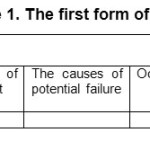 |
Table 1: The first form of FMEA Click here to View table |
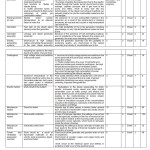 |
Table 2: The completed Report of FMEA on risks before fire in passenger trains in tunnels Click here to View table |
Possible Risks Following Fire in Passenger Train in Tunnels (Risk type 2)
In this step, the possible risks which occur after fire are identified, then they are put in the form of FMEA, and the RPN is calculated.
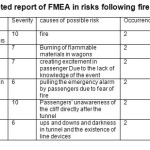 |
Table 3: The completed report of FMEA in risks following fire in trains in tunnels Click here to View table |
Applying Fuzzy Theory to Improve the Performance of FMEA Model
Since one of the FMEA model goals is to select the improved performance to decrease the risks and defects, so the options that have higher risks of defect must be emphasized. Therefore, there is always a RPN which is the product of the severity, occurrence probability, and detection probability.
RPN=S*O*D
Finally, RPN can identify the possible causes and define the corrective measures and the sources of high-risk errors. In this method, the human thinking and sense are the basis for operation. So, we face a vague concept which cannot be precisely quantified in the three parameters. In the other hand, ascribing a number between 1 and 10 to the risk factors is so difficult for the team with multiple specialties, and disagreement may occur among the members. Regarding the necessity of ultimate decision making on the causes of unconformity in the analysis systems of errors and effects and imprecise parameters, it seems that the fuzzy theory is able to give a mathematical configuration to the vague and imprecise variables required for calculating the RPN, and pave the way for final prioritization of the causes of unconformity.(Kyanfar et al. 1383).
A model to calculate the degree of risk priority through fuzzy theory
In order to calculate the degree of priority risk and prioritize the errors and effects through the fuzzy theory, two main steps are necessary:
Selecting a fuzzy membership function
Five verbal variables-very low, low, average, high, and very high - are used for all the effective factors –severity, error occurrence probability, and error detection probability, to calculate the fuzzy membership function.
The values ​​of the verbal variable=T (X) = {very low, low, average, high, very high}
U (Reference set) the range = [0, 1]
The membership function of the verbal variables is as follows:
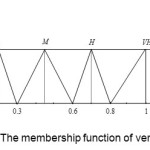 |
Figure 1: The membership function of verbal variables Click here to View figure |
Using the Non- Fuzzy Method (Ranking the left and right of the Fuzzy Number)
The left and right numbers of a fuzzy number can be calculated as follows:
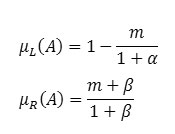
So, by using the ranking method to the right and left of a fuzzy number and giving a certain real score to the verbal variables of the fuzzy numbers, a determinate scoring is assigned to each fuzzy number. (Table 4). After getting the precise parameters using the FMEA model which is the product of the severity, occurrence and detection, we prioritize the risks and effects.
Table 4: Scoring the Fuzzy Number the left and right exact values allocated to each fuzzy number
|
Overall number |
Left number |
Right number |
Fuzzy |
Verbal variable |
|
0.046 |
1 |
0.91 |
(0,0, 0.1) |
VL |
|
0.227 |
0.82 |
0.273 |
(0.1, 0.2, 0.3) |
Calque |
|
0.457 |
0.609 |
0.522 |
(0.3, 0.45, 0.6) |
M |
|
0.682 |
0.364 |
0.727 |
(0.6, 0.7, 0.8) |
That |
|
0.917 |
0.167 |
1 |
(0.8, 1, 1) |
VH |
FMEA table through triangular fuzzy membership function (prior to fire)
Here, each parameters of possible risks is given a verbal variable regarding its value.
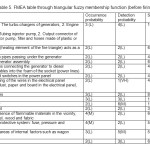 |
Table 5: FMEA table through triangular fuzzy membership function (before firing) Click here to View table |
Correcting the numbers in table 2 through the fuzzy theory
According to results of table 4(fuzzy membership function), the no fuzzy values of occurrence probability, detection probability, severity and RPN are used to improve the performance of FMEA model as shown in Table 6.
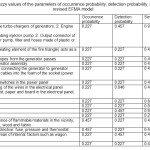 |
|
FMEA Table through triangular fuzzy membership function(After firing, risk 2)
In this section, a verbal variable is assigned to each parameter of possible risk regarding its value as presented in Table7.
Table 7: FMEA table through triangular fuzzy membership function after firing
|
Possible risk |
Occurrence Probability |
Detection probability |
Severity |
RPN |
Priority |
|
Smoke and poisonous gases |
2(L) |
3(L) |
10(VH) |
60 |
3 |
|
Direct contact with fire |
2 (L) |
3(L) |
7(H) |
42 |
5 |
|
Rush the exit door to escape |
2(L) |
5(M) |
7(H) |
70 |
2 |
|
The train stops at insecure place |
2(L) |
4(M) |
6(M) |
48 |
4 |
|
A cliff located directly after the tunnel |
2(L) |
4(M) |
10(VH) |
80 |
1 |
Correcting the numbers in table 2 through fuzzy theory
According to results of table 4 (fuzzy membership function), the non- fuzzy values of occurrence probability, detection probability, severity, and RPN are used to improve the performance of the FMEA model as shown in Table 8.
Table 8: Non-fuzzy values of the occurrence probability, detection probability, severity, RPN- the revised EFMA model
|
Possible risk |
Occurrence |
Detection probability |
Severity |
RPN |
priority |
|
Smoke and poisonous gases |
0.227 |
0.227 |
0.917 |
0.047 |
3 |
|
Direct contact with fire |
0.227 |
0.227 |
0.682 |
0.035 |
4 |
|
Rush the exit door to escape |
0.227 |
0.457 |
0.682 |
0.070 |
2 |
|
The train stops at unsafe place |
0.227 |
0.457 |
0.457 |
0.047 |
3 |
|
A cliff located directly after the tunnel |
0.227 |
0.457 |
0.917 |
0.095 |
1 |
Conclusion
In the assessment of fire risk in passenger trains in railway tunnels, two types of risks are possible. The risk type 1 (before fire) leads to fire in trains, and the most important factors (priority 1)-in Table 6- include the high temperature of the he turbo-chargers of generators, and of the engine exhaust manifold. Fuel spill from the pipes of the injector pump, Output connector hoses of the injector pump, filter, and malfunctioning of the safety system (fuse, pressure and thermostat) are considered as average priorities. Excessive temperature in the wires in the electrical panel, the presence flammable materials, dust, paper and board in the electrical panel, can lead to fire, which is considered as the last priority. So, some special preventive measures should be taken, including continuous controls and checkups of convertors, generators, Braking systems on wagons, mechanical factors and electronic factors, In addition, the replacement of damaged or defected parts is essential. It is imperative that the train personnel receive technical training. In the assessment of the risk type 2, as seen in Table 8, the most important and high- risk parameters are assigned to tunnels 22 and 23 of Zagros Railway. The cliffs located directly after the tunnel, evacuation of passengers, and rush to the exit doors to escape are regarded as the factors that can intensify the fire effects. It can be concluded that, research and case studies on fire in passenger trains in each part of the national rail way is of great importance, and that comparisons of similarities in the patterns of, and solutions to fire in each area can be used to give responses to certain risks in each area but each has its own characteristics. In addition, the scenarios which occur following a fire, have direct effects on increase in damages, and human mortalities. So, the risk type 2 is more serious than the risk type 1.
References
- Bolbol Amiri, N, & Nasir Zadeh, f. (2009). Application of FMEA Fuzzy approach to risk assessment related to system failures, signaling, clues, control and contacts of subway, Second International Conference of Recent Developments in Railway Engineering.
- Bolbol Amiri, N, & Asadi Lari, E. (2010). Fire risk assessment of passenger trains in Iran through FMEA fuzzy, Convergence theory, transportation Engineering, First Year, N. 4.
- Daneshvar, S., Mortazavi, S. B., & Atr Kar Roshan, S. (1392). Fire Risk Assessment Overhead resistance to flow smoothly in Tehran subway through error analyses, Journal of Occupational Medicine Specialist, Fifth Vol, No. 3, pp. 42-48.
- Hudson, S. (2001). Rail way safety working for a safer railway: Train fires-special topic report, Published by the Controller, Safety. Strategy & Risk Euston Road London NW12DX.
- Jafarian, a., & Rezvani, M. E. (2010). Assessment the loss of life of adverse events caused by the passenger trains fire through error analyses and uniform events, Seventh International Conference of Industry Engineering, Isfahan.
- Kyianfar, F., Najmi, M., & Ebrahimi, M. (2004). Calculate the degree of risk preference in FMEA model through fuzzy theory, Second International Conference of Management, Tehran, Research Department of Ariana, The Department of Management and Economic of Sanati Sharif University.
- Lin, C. J. & Chauh, Y. K. (2008). A study on long tunnel smoke extraction strategies by numerical simulation. Tunneling and Underground Space Technology, 23, pp. 522-530.
- Seong, J. H, Ryon, H. S., Park, W. H. & Jang, Y. J. (2009). CFD simulation and assessment of life safety in a subway train fire, Tunneling and Underground Space Technology, 24, pp. 447-453.
- Zivdar, H., & Shahbaz Nejad, H. (20014). Vulnerability assessment resulting from fires in passenger trains in tunnels through APH (A case study in the Zagros Railway), First National Conference of High-Speed Railway in Iran.






